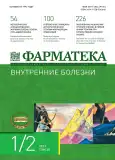TSLP gene polymorphic rs1837253 variants in occupational asthma
- Authors: Babanov S.A.1, Baykova A.G.1, Lavrentieva N.E.1, Strizhakov L.A.2, Lotkov V.S.1
-
Affiliations:
- Samara State Medical University
- Sechenov University
- Issue: Vol 30, No 1/2 (2023)
- Pages: 156-160
- Section: Pulmonology/ENT/ARVI
- Published: 15.06.2023
- URL: https://journals.eco-vector.com/2073-4034/article/view/462771
- DOI: https://doi.org/10.18565/pharmateca.2022.1-2.156-160
- ID: 462771
Cite item
Abstract
Background. Occupational asthma (OA) is an urgent medical and social problem due to the prevalence, severity of the course, the complexity of diagnosis and choice of therapy, and high treatment costs. In the pathogenesis of occupational asthma as a multifactorial disease, several complex interrelated polymorphic genetic and biochemical systems are involved, and individual characteristics of the organism are also should be taken into account, so study and search for informative markers of various forms of OA are relevant. Molecular genotyping opens up new opportunities in the search for a more targeted and personalized approach to the treatment of OA, as well as in the development of an individual strategy for its prevention.
Objective. The study was aimed to the determination of the genetic markers of the risk of developing OA under the exposure to sensitizing substances by assessing TSLP (thymic stromal lymphopoietin) gene polymorphic rs1837253 variants.
Methods. The study was conducted with the participation of 170 patients with different OA phenotypes and 50 people in the control group: the group 1 (42 patients) – «occupational asthma, allergic form» phenotype; group 2 (36 patients) – «occupational asthma, non-allergic form» phenotype; group 3 (58 people) – «occupational asthma – occupational chronic obstructive pulmonary disease (COPD)» phenotype; group 4 (34 patients) – «occupational bronchial asthma – metabolic syndrome» phenotype, group 5 – control group (healthy) – 50 people. As part of the study of genetic predisposition to OA, TSLP genetic rs1837253 polymorphisms were determined. DNA samples were isolated from peripheral venous blood lymphocytes by phenol-chloroform extraction. Genotyping was performed by real-time polymerase chain reaction using primers and probes developed using the PrimerQuest program (Intergrated DNA Technologies, Inc.).
Results. For the first time, genetic markers of OA risk under exposure to sensitizing substances, TSLP gene polymorphic rs1837253 variants were identified, which makes it possible to recommend determining these genetic markers during regular medical examinations in persons working under exposure to sensitizing and irritating substances in the presence of clinical, functional, immunological changes.
Conclusion. The marker OA genotype profiles identified can optimize the approach to the diagnosis, treatment and prevention of this pathology, as well as expand the range of criteria for predicting the course of the disease.
Full Text
About the authors
S. A. Babanov
Samara State Medical University
Email: lavrenteva.natalia@yandex.ru
ORCID iD: 0000-0002-1667-737X
Russian Federation, Samara
A. G. Baykova
Samara State Medical University
Email: lavrenteva.natalia@yandex.ru
ORCID iD: 0000-0003-3438-6602
Russian Federation, Samara
Natalya E. Lavrentieva
Samara State Medical University
Author for correspondence.
Email: lavrenteva.natalia@yandex.ru
ORCID iD: 0000-0002-7571-0328
Cand. Sci. (Med.), Associate Professor at the Department of Occupational Diseases and Clinical Pharmacology n.a. Honoured Scientist of the Russian Federation, Professor V.V. Kosarev
Russian Federation, SamaraL. A. Strizhakov
Sechenov University
Email: lavrenteva.natalia@yandex.ru
ORCID iD: 0000-0002-2291-6453
Russian Federation, Moscow
V. S. Lotkov
Samara State Medical University
Email: lavrenteva.natalia@yandex.ru
ORCID iD: 0000-0002-3995-6988
Russian Federation, Samara
References
- Курбачева О.М. Бронхиальная астма. Что можно сделать для достижения контроля заболевания. Российский аллергологический журнал. 2012;2:28–34. [Kurbacheva O.M. Bronchial asthma. What can be done to achieve disease control. Rossiiskii allergologicheskii zhurnal. 2012;2:28–34. (In Russ.)].
- Tilles S.A., Jerath1Tatum A. Differential diagnosis of occupational asthma. Immunol Allergy Clin N Am. 2003;23:167–76. doi: 10.1016/s0889-8561(02)00089-9.
- Sastre J., Vandesplas O., Park H.1S. Pathogenesis of occupational asthma. Eur Respir J. 2003;22:364–67. doi: 10.1183/09031936.03.00045103.
- Симбирцев А.С. Цитокины в патогенезе и лечении заболеваний человека. СПб., 2018. 512 с. [Simbirtsev A.S. Cytokines in the pathogenesis and treatment of human diseases. St. Petersburg, 2018. 512 p. (In Russ.)].
- Ризванова Ф.Ф., Пикуза О.И., Файзуллина Р.А. и др. Генетическая диагностика: полиморфизм генов цитокинов. Практическая медицина. 2010;6(45):41–3. [Rizvanova F.F., Pikuza O.I., Fayzullina R.A. Genetic diagnostics: polymorphism of cytokine genes. Prakticheskaya meditsina. 2010;6(45):41–3. (In Russ.)].
- Цыган В.Н., Иванов А.М., Камилова Т.А. и др. Генетический полиморфизм цитокинов. Вестник Российской военно-медицинской академии. 2010;2(30):211–19. [Tsygan V.N., Ivanov A.M., Kamilova T.A. et al. Genetic polymorphism of cytokines. Vestnik Rossiiskoi voenno-meditsinskoi akademii. 2010;2(30):211–19. (In Russ.)].
- Wan H., Winton H.L., Soeller C., et al. Der p1 facilitates transepithelial allergen delivery by disruption of tight functions. J Clin Invest. 1999;104:123–33. doi: 10.1172/JCI5844.
- Agius R.M., Nee J., Mc Govern B., Robertson A. Structure activity hypotheses in occupational asthma caused by low molecular weight substances. Ann Occup Hyg. 1991;35:129–31. doi: 10.1093/annhyg/35.2.129.
- Cormier M., Lemiеre C. Occupational asthma. Int J Tuberc Lung Dis. 2020;24(1):8–21.
- Vandenplas O., Suojalehto H., Cullinan, P. Diagnosing occupational asthma. Clin Exp Allergy. 2017;47(1):6–18. doi: 10.1111/cea.12858.
- O’Rourke R.W., White A.E., Metcalf M.D., et al. Hypoxia-induced inflammatory cytokine secretion in human adipose tissue stromovascular cells. Diabetol. 2011;54(6):1480–90. doi: 10.1007/s00125-011-2103-y.
- Lee H.Y., Min K.H., Lee S.M., et al. Clinical significance of serum vascular endothelial growth factor in young male asthma patients. Korean J Intern Med. 2017;32(2):295–301. doi: 10.3904/kjim.2014.242.
Supplementary files





